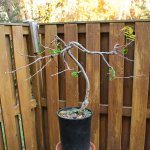lieuz
Chumono
In a month it'll be my wisteria's anniversary being in my care. I've posted some pictures on here last year but wanted to to post another one showing the condition its in currently. I wanted to get some tips from wisteria growers on how to prune wisteria in spring. Most of the literature I've found on pruning are for very large wisteria plants and are all grown in the ground. I wasn't sure if any of the literature I found, can be applied to a bonsai form of that tree. If I were to do what normal wisteria growers do in spring, I would be pruning the branches down to about 2 buds to encourage flower growth.
Here is a picture of my wisteria oct 31 of 2014.

I really like the shape it is in now. It bloomed last year so I know it'll definitely bloom this year. Can I leave this as is and still get amazing flower blooms, assuming that I will fertilize the crap out of this guy, without pruning it? Or should I prune it down to 2 buds, also fertilizing the crap out of this guy.
Here is a picture of my wisteria oct 31 of 2014.

I really like the shape it is in now. It bloomed last year so I know it'll definitely bloom this year. Can I leave this as is and still get amazing flower blooms, assuming that I will fertilize the crap out of this guy, without pruning it? Or should I prune it down to 2 buds, also fertilizing the crap out of this guy.






